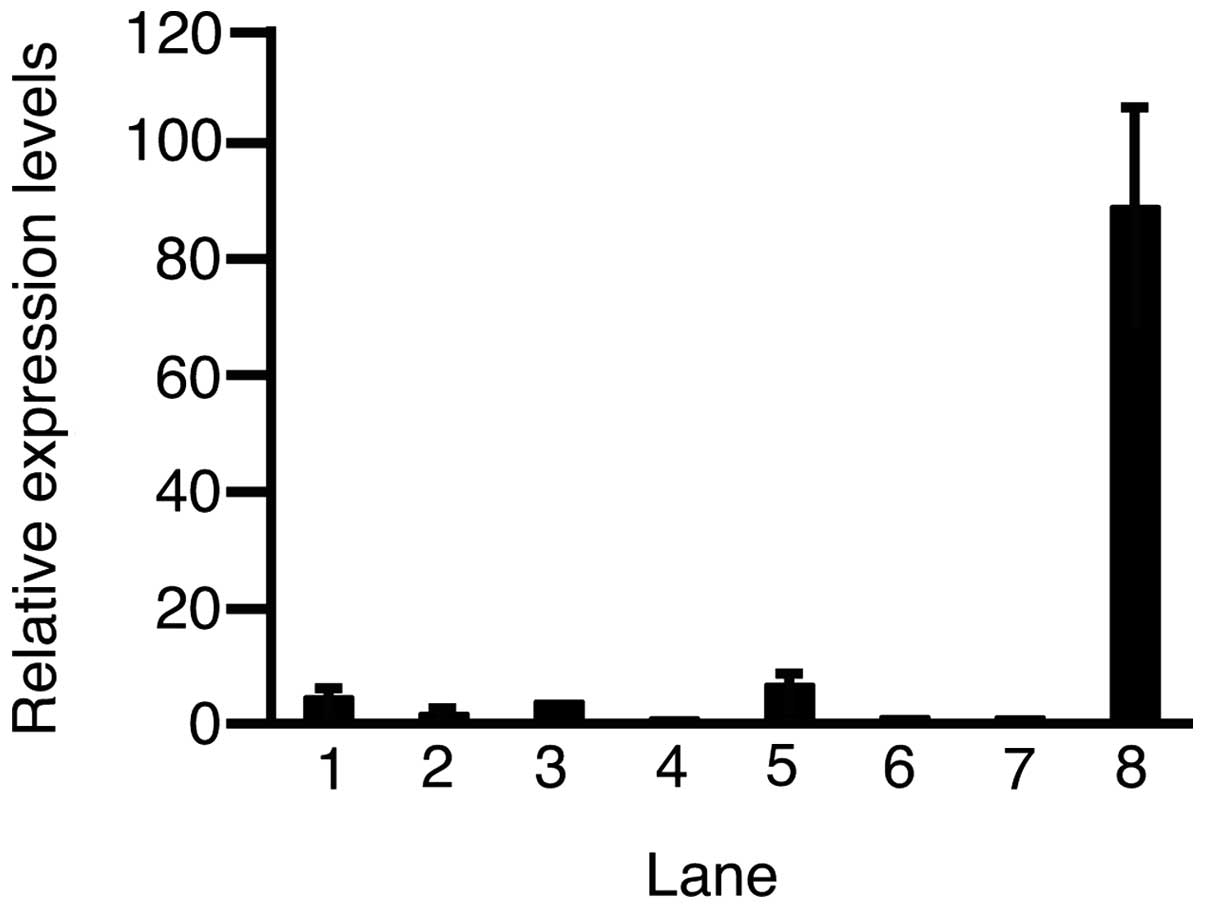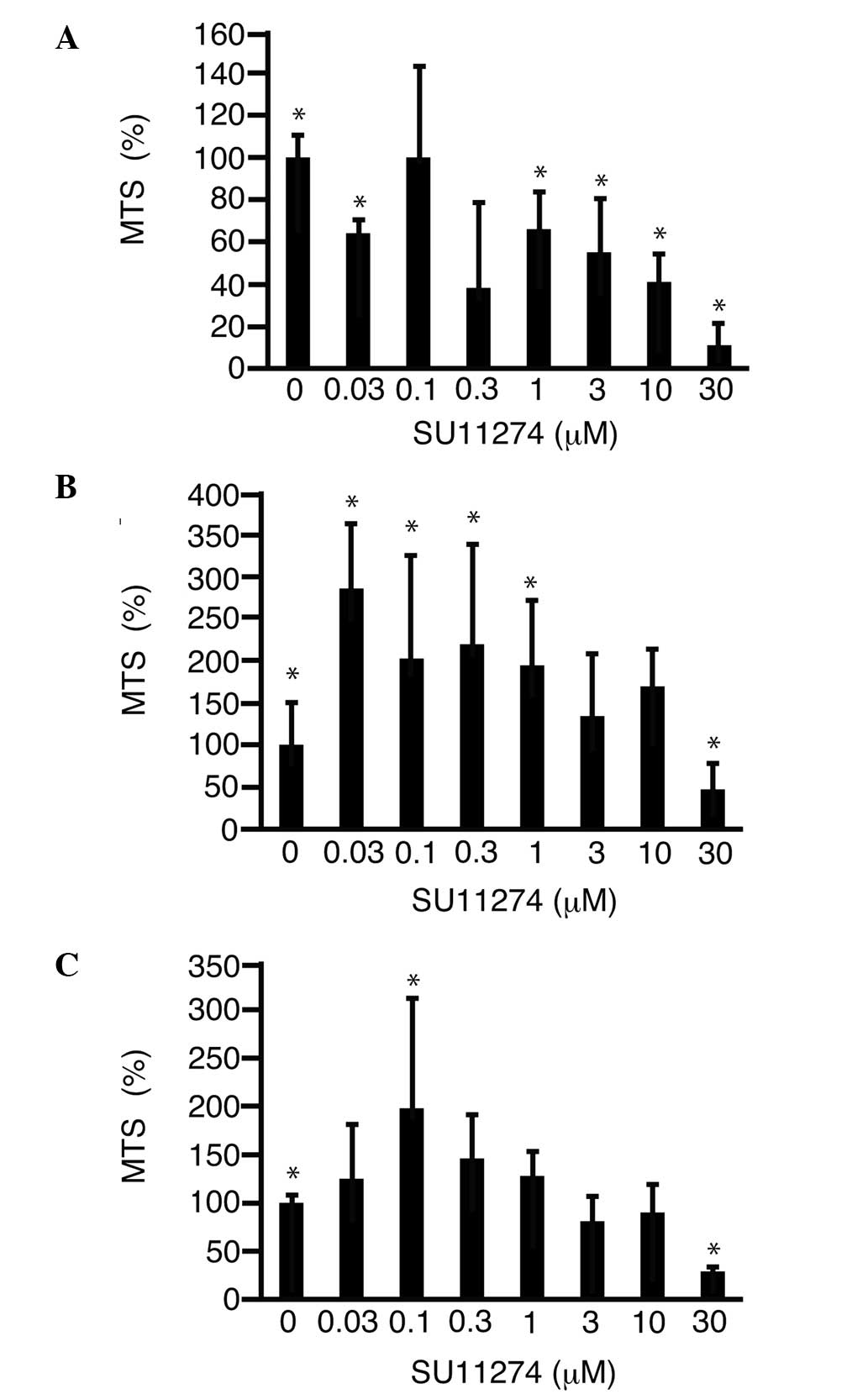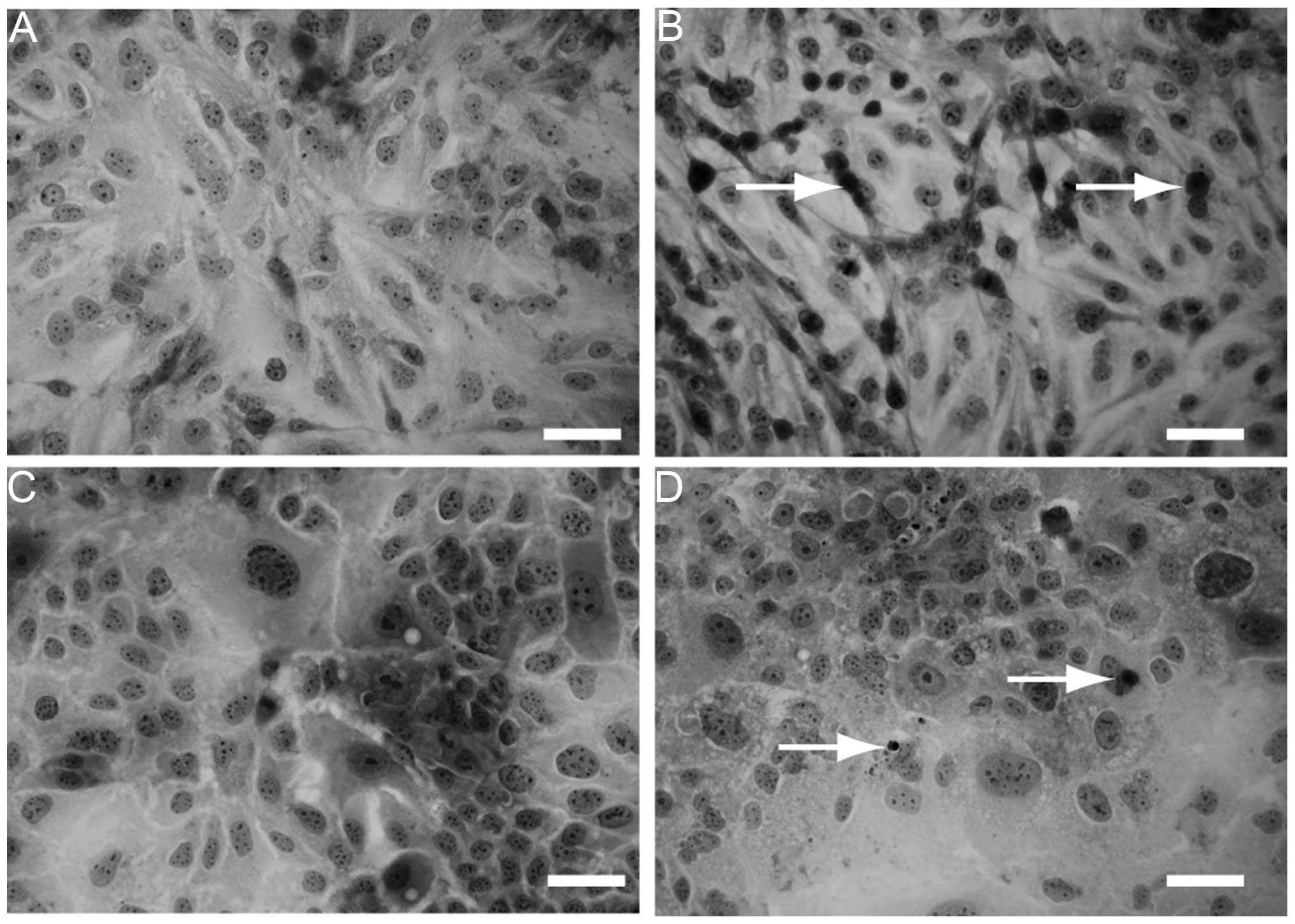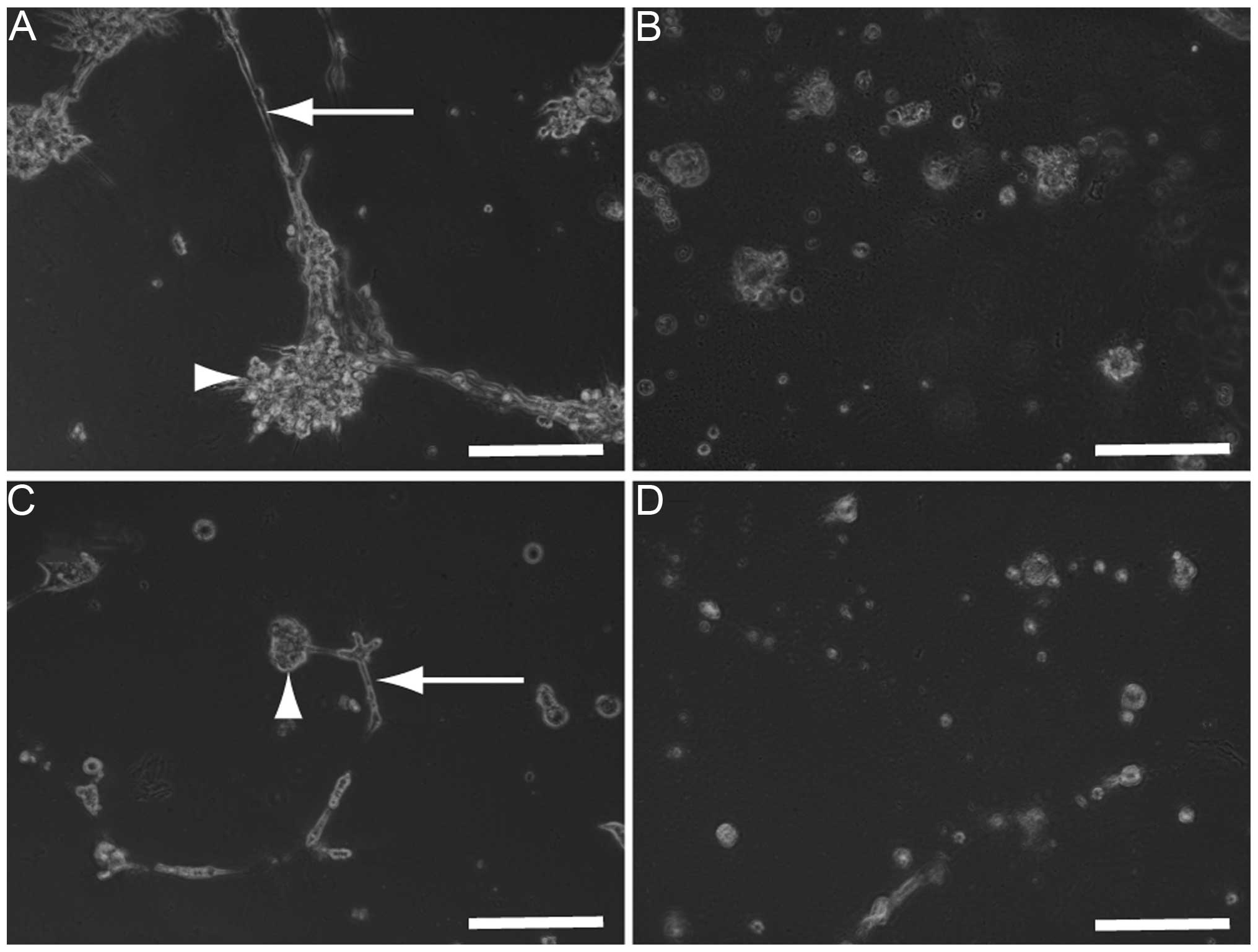Co‑culture of hepatocellular carcinoma cells and human umbilical endothelial cells damaged by SU11274
- Authors:
- Published online on: September 10, 2014 https://doi.org/10.3892/br.2014.361
- Pages: 799-803
Abstract
Introduction
Hepatocellular carcinoma (HCC) is a common malignancy of the liver with a poor prognosis. HCC is treated with local ablation, surgical resection, transcatheter arterial chemoembolization and systemic administration of chemotherapeutic agents (1,2). The HCC tissue obtains nutrients and oxygen from blood vessels by the process of angiogenesis (3,4). Vascular endothelial cells proliferate by activating the mitogen-activated protein (MAP) kinase pathway, which acts downstream of the vascular endothelial cell growth factor (VEGF) receptor (5). Sorafenib, a multikinase inhibitor of VEGF, inhibits the MAP kinase pathway and is used to treat HCC (6,7). Despite the sorafenib treatment, >25% of patients with HCC succumb from disease progression (8). Thus, it is necessary to investigate alternative drugs/reagents alone or in combination with sorafenib that can inhibit the signaling pathways involved in the proliferation of HCC.
Mesenchymal-epithelial transition factor (c-Met) is a receptor of the hepatocyte growth factor (HGF) (9). When HGF binds to c-Met, it stimulates downstream signaling via the phosphatidylinositol-3 kinase pathway and MAP kinase. Since c-Met is upregulated in HCC tissues compared to the surrounding normal tissues (10,11), inhibitors of c-Met, including (3Z)-N-(3-chlorophenyl)-3-({3,5-dimethyl -4-[(4-methylpiperazin-1-yl)carbonyl]-1H-pyrrol -2-yl}methylene)-N-methyl-2-oxo-2,3-dihydro-1H-indole-5-sulf onamide (SU11274), are considered to be promising candidates for the treatment of HCC (12). SU11274 competes with adenosine triphosphate to bind to the activation loop of c-Met (13). SU11274 is known to suppress the proliferation of HCC cells (14), and if SU11274 can also suppress angiogenesis, the anti-tumor effects are expected to be stronger.
Thus, the aim of the present study was to establish a co-culture of HCC and human umbilical vein endothelial cells (HUVECs) as an in vitro model of the HCC tissue and to investigate the anti-tumor effects of SU11274.
Materials and methods
Ethical statement
The study was approved by the Ethics Committee of National Hospital Organization Shimoshizu Hospital (Yotsukaido, Japan). Human fetal and adult liver RNA were collected with informed consent from the donors and their relatives by Clontech Laboratories, Inc., (Mountain View, CA, USA). All the human tissue samples were collected with informed consent from the donors and their relatives by BioChain (Hayward, CA, USA).
Cell culture
HCC cell lines (HLE, HLF, PLC/PRL/5, Hep3B and HepG2) were purchased from RIKEN Cell Bank (Tsukuba, Japan). The cells were cultured in Dulbecco’s modified Eagle’s medium (DMEM; Sigma-Aldrich, St. Louis, MO, USA) and supplemented with 10% fetal bovine serum (FBS; Life Technologies, Grand Island, NY, USA). HUVECs and their culture medium [endothelial cell growth media bullet kit (EGM)] were purchased from Lonza (Walkersville, NJ, USA). The cell lines were cultured in 5% carbon dioxide at 37°C in a humidified chamber. The cultured cells were observed under a microscope (CKX41N-31PHP; Olympus, Tokyo, Japan).
Hematoxylin and eosin (H&E) staining
The cells were spread onto 4-well chambers (Beckton Dickinson, Franklin Lakes, NJ, USA), fixed with 100% methanol at room temperature and stained with H&E staining (Muto Pure Chemicals Co., Ltd., Tokyo, Japan). The specimens were observed and images were captured using an AX80 microscope (Olympus).
Co-culture of HLF or PLC/PRL/5 cells with HUVECs
HUVECs were spread at a density of 1.9×104 cells onto each well of a 24-well plate coated with matrigel (Becton Dickinson) at the density of each well. After 1-day culture in EGM, the medium was discarded and 1.9×104 HLF cells or PLC/PRL/5 cells were spread onto each well. The cells were cultured in DMEM supplemented with 10% FBS.
Immunostaining
Serial sections of human healthy adult liver (64-year-old male) and HCC tissue (60-year-old female) (BioChain) were deparaffinized, autoclaved and incubated with hydrogen peroxide, followed by 2% FBS in phosphate-buffered saline (PBS; washing buffer) for 30 min. Following an overnight incubation with rabbit monoclonal anti-c-Met antibody (1:300; Cell Signaling Technology, Danvers, MA, USA), the specimens were rinsed with PBS and incubated with horseradish peroxidase-labeled anti-rabbit antibody (1:2,000; GE Healthcare, Pittsburgh, PA, USA) for 2 h. Subsequently, diaminobenzidine (Dako, Glostrup, Denmark) was applied to the tissue sections as a chromogen and the nuclei were stained with hematoxylin for 15 sec. The specimens were observed and the images were captured under an AX80 microscope (Olympus). A specimen of HCC tissue incubated without the primary antibody was used as a negative control.
Cell proliferation analysis
HLF cells, PLC/PRL/5 cells or HUVECs were trypsinized, harvested, spread onto 96-well flat-bottom plates (Asahi Techno Glass, Tokyo, Japan) at a density of 1,000 cells per well and were incubated for 24 h in media supplemented with 10% FBS. The cells were treated with the c-Met inhibitor, SU11274 (Wako Pure Chemicals, Tokyo, Japan) at 0, 0.03, 0.1, 0.3, 1, 3, 10 and 30 μM for 72 h. These cells were subsequently used in the 3-(4,5-dimethylthiazol-2-yl)-5-(3-carboxymethoxyphenyl)-2-(4-sulfophenyl)-2H-tetrazolium, inner salt (MTS) assays, according to the manufacturer’s instructions (Promega Corporation, Madison, WI, USA). MTS is bioreduced by the cells into a colored formazan product into a colored formazan product. The absorbance was analyzed at a wavelength of 490 nm with an iMark Microplate Absorbance Reader (Bio-Rad, Hercules, CA, USA). The absorbance was normalized against that of 0 μM.
Reverse transcription quantitative polymerase chain reaction (RT-qPCR)
The cells were spread in 6-well plates (Asahi Techno Glass) and cultured until they reached 80% confluency. SU11274 was added to the media and 48 h later, total RNA was isolated using a kit (Isogen; Nippon Gene, Tokyo, Japan). Complimentary DNA was synthesized using SuperScript III and oligo(dT) primers (Life Technologies), as per the manufacturer’s instructions. Total RNA from adult human healthy liver was purchased from Clontech Laboratories, Inc. The PCR primers and product sizes were as follows: c-Met 77 [NM_000245; 5′-CATTGGGGAGCACTATGTC-3′ (forward), 5′-TGT 78 CCACCTCATCATCAGCG-3′ (reverse); 110 basepairs (bp)], cyclin D1 (NM_053056; 5′-AGAGGCGGAGGA GAACAAACAG-3′, 5′-AGGCGGTAGTAGGACAGGAAG TTG-3′; 180 bp) and RPL19 (BC095445; 5′-CGAATGCCAG AGAAGGTCAC-3′, 5′-CCATGAGAATCCGCTTGTTT-3′; 157 bp). RT-qPCR was performed at 40 cycles consisting of denaturing for 5 sec and annealing-extension for 5 sec. RPL19 primers were used as the internal controls. RT-qPCR was performed using the Fast SYBR-Green Master mix (Life Technologies) in the MiniOpticon system (Bio-Rad). The expression level of the genes was analyzed automatically with the system. The expression levels were normalized against that of 0 μM.
Statistical analyses
One-way analysis of variance was performed with JMP 10.0.2 (SAS Institute, Cary, NC, USA). P<0.05 was considered to indicate a statistically significant difference.
Results
c-Met expression
The expression of c-Met was analyzed immunohistochemically in 99 surgical specimens of adult healthy liver and HCC samples from 100 that were commercially available. In the absence of the anti-c-Met antibody, HCC tissues did not show any staining (Fig. 1A). While the cell membrane of hepatocytes in the normal liver was weakly positive for c-Met (Fig. 1B), the cell membrane and cytoplasm of cells in the HCC tissue were positive (Fig. 1C). These data indicate that c-Met is upregulated in HCC cells as compared to the normal hepatocytes.
Subsequently, RT-qPCR was performed to assess the expression level of c-Met in the HCC cell lines and HUVECs (Fig. 2). The expression levels of c-Met in HLE, HLF, PLC/PRL/5, Hep3B, Huh-6, HepG2, adult healthy liver and HUVECs were 4.43±0.50, 1.61±0.18, 3.70±0.08, 0.81±0.18, 6.60±1.29, 1.06±0.35, 1.00±0.09 and 88.8±17.3 (mean ± standard deviation), respectively. Except in Hep3B cells, the expression of c-Met was higher in all the HCC cell lines and HUVECs as compared to the adult healthy liver.
c-Met inhibition by SU11274
To address the possibility that inhibition of c-Met suppresses cell proliferation, SU11274 was added to the media and the MTS assay was performed. SU11274 was found to suppress the proliferation of HLF cells in a dose-dependent manner and reached 11.0±9.4% (P<0.05) with 30 μM SU11274 as compared to 0 μM (Fig. 3A). SU11274 (30 μM) suppressed the proliferation of PLC/PRL/5 cells (Fig. 3B) and HUVECs (Fig. 3C) to 46.5±30.7 (P<0.05) and 29.4±5.0%, as compared to 0 μM (P<0.05), respectively.
To investigate the mechanism of cell proliferation suppression by SU11274, the expression level of cyclin D1 was analyzed by RT-qPCR and was found to decrease to 45.1±11.6% (P<0.05) with 30 μM SU11274 in HLF cells, as compared to 0 μM (Fig. 4A). The expression level of cyclin D1 decreased to 30.1±10.3% (P<0.05) of SU11274 in PLC/PRL/5 cells, as compared to 0 μM (Fig. 4B).
In addition, H&E staining was performed to observe the morphological changes of the cells cultured with or without SU11274. Compared to HLF (Fig. 5A) and PLC/PRL/5 cells (Fig. 5C) without SU11274 treatment, apoptotic cells were observed with 30 μM SU11274 treatment (Fig. 5B and D).
Co-cultures of HLF (Fig. 6A) or PLC/PRL/5 cells (Fig. 6C) with HUVECs were established to analyze the possibility that SU11274 damages the co-culture used as an in vitro model of hepatoma tissues. Three days after the addition of 30 μM SU11274, the morphology of the co-cultures of HLF (Fig. 6B) or PLC/PRL/5 cells (Fig. 6D) with HUVECs were found to be damaged and as a result, all the cells died.
Discussion
SU11274 suppresses proliferation and induces apoptosis of HCC cells (15). In the present study, proliferation of HCC cells was suppressed via the downregulation of cyclin D1, a protein involved in cell cycle progression (16,17). These results indicate that SU11274 can suppress cell cycle progression. In addition, H&E staining showed apoptosis in cells cultured with SU11274. SU11274 is known to activate caspase-3 (15). Taken together, these data indicate that SU11274 suppresses the proliferation of HLF and PLC cells by downregulating cyclin D1 and inducing apoptosis.
c-Met is expressed in vascular endothelial cells and is upregulated along with HGF in response to environmental stress (18,19). The results of the present study show that c-Met is expressed in HUVECs and the proliferation of HUVECs is suppressed by SU11274. This indicates that SU11274 may suppress the proliferation of HCC cells and HUVECs. Co-cultures of HLF or PLC/PRL/5 cells and HUVECs were established to assess the anti-proliferative effects of SU11274. The data clearly show that these co-cultures were damaged by SU11274 treatment, indicating that SU11274 may be useful for the suppression of proliferation of HCC cells, as well as angiogenesis.
In conclusion, except for Hep3B, c-Met is highly expressed in hepatoma cells and HUVECs. SU11274 (30 μM) suppresses the proliferation of HLF, PLC/PRL/5 and HUVECs and it was found that 30 μM SU11274 damaged the co-culture of HLF or PLC/PRL/5 cells with HUVECs.
References
|
Lencioni R, Petruzzi P and Crocetti L: Chemoembolization of hepatocellular carcinoma. Semin Intervent Radiol. 30:3–11. 2013. View Article : Google Scholar | |
|
Kim HY and Park JW: Clinical trials of combined molecular targeted therapy and locoregional therapy in hepatocellular carcinoma: past, present, and future. Liver Cancer. 3:9–17. 2014. View Article : Google Scholar : PubMed/NCBI | |
|
Tomizawa M, Kondo F and Kondo Y: Growth patterns and interstitial invasion of small hepatocellular carcinoma. Pathol Int. 45:352–358. 1995. View Article : Google Scholar : PubMed/NCBI | |
|
Miyahara K, Nouso K, Morimoto Y, et al: Okayama Liver Cancer Group: Pro-angiogenic cytokines for prediction of outcomes in patients with advanced hepatocellular carcinoma. Br J Cancer. 109:2072–2078. 2013. View Article : Google Scholar : PubMed/NCBI | |
|
Xie B, Wang DH and Spechler SJ: Sorafenib for treatment of hepatocellular carcinoma: a systematic review. Dig Dis Sci. 57:1122–1129. 2012. View Article : Google Scholar : PubMed/NCBI | |
|
Furuse J, Ishii H, Nakachi K, Suzuki E, Shimizu S and Nakajima K: Phase I study of sorafenib in Japanese patients with hepatocellular carcinoma. Cancer Sci. 99:159–165. 2008.PubMed/NCBI | |
|
Hu H, Duan Z, Long X, et al: Sorafenib combined with transarterial chemoembolization versus transarterial chemoembolization alone for advanced-stage hepatocellular carcinoma: a propensity score matching study. PLoS One. 9:e966202014. View Article : Google Scholar | |
|
Nishikawa H, Takeda H, Tsuchiya K, et al: Japanese Red Cross Liver Study Group: Sorafenib therapy for BCLC stage B/C hepatocellular carcinoma; clinical outcome and safety in aged patients: a multicenter study in Japan. J Cancer. 5:499–509. 2014. View Article : Google Scholar | |
|
Organ SL and Tsao MS: An overview of the c-MET signaling pathway. Ther Adv Med Oncol. 3(Suppl 1): S7–S19. 2011. View Article : Google Scholar : PubMed/NCBI | |
|
Grigioni WF, Fiorentino M, D’Errico A, et al: Overexpression of c-met protooncogene product and raised Ki67 index in hepatocellular carcinomas with respect to benign liver conditions. Hepatology. 21:1543–1546. 1995.PubMed/NCBI | |
|
Kang GH, Lee BS, Lee ES, Kim SH, Lee HY and Kang DY: Prognostic significance of p53, mTOR, c-Met, IGF-1R, and HSP70 overexpression after the resection of hepatocellular carcinoma. Gut Liver. 8:79–87. 2014. View Article : Google Scholar : PubMed/NCBI | |
|
Scagliotti GV, Novello S and von Pawel J: The emerging role of MET/HGF inhibitors in oncology. Cancer Treat Rev. 39:793–801. 2013. View Article : Google Scholar : PubMed/NCBI | |
|
Mughal A, Aslam HM, Sheikh A, Khan AM and Saleem S: c-Met inhibitors. Infect Agent Cancer. 8:132013. View Article : Google Scholar | |
|
Inagaki Y, Qi F, Gao J, et al: Effect of c-Met inhibitor SU11274 on hepatocellular carcinoma cell growth. Biosci Trends. 5:52–56. 2011. View Article : Google Scholar : PubMed/NCBI | |
|
Dang Y, Luo D, Rong M and Chen G: Underexpression of miR-34a in hepatocellular carcinoma and its contribution towards enhancement of proliferating inhibitory effects of agents targeting c-MET. PLoS One. 8:e610542013. View Article : Google Scholar : PubMed/NCBI | |
|
Tomizawa M, Shinozaki F, Sugiyama T, Yamamoto S, Sueishi M and Yoshida T: Insulin-like growth factor I receptor involvement in proliferation of NOR-P1 cells in serum-free media. J Cell Biochem. 113:2714–2720. 2012. View Article : Google Scholar : PubMed/NCBI | |
|
Tomizawa M, Shinozaki F, Motoyoshi Y, et al: Niclosamide suppresses hepatoma cell proliferation via the Wnt pathway. Onco Targets Ther. 6:1685–1693. 2013. View Article : Google Scholar : PubMed/NCBI | |
|
Harrington LS, Sainson RC, Williams CK, et al: Regulation of multiple angiogenic pathways by DII4 and Notch in human umbilical vein endothelial cells. Microvasc Res. 75:144–154. 2008. View Article : Google Scholar : PubMed/NCBI | |
|
Hu SY, Duan HF, Li QF, et al: Hepatocyte growth factor protects endothelial cells against gamma ray irradiation-induced damage. Acta Pharmacol Sin. 30:1415–1420. 2009. View Article : Google Scholar : PubMed/NCBI |















